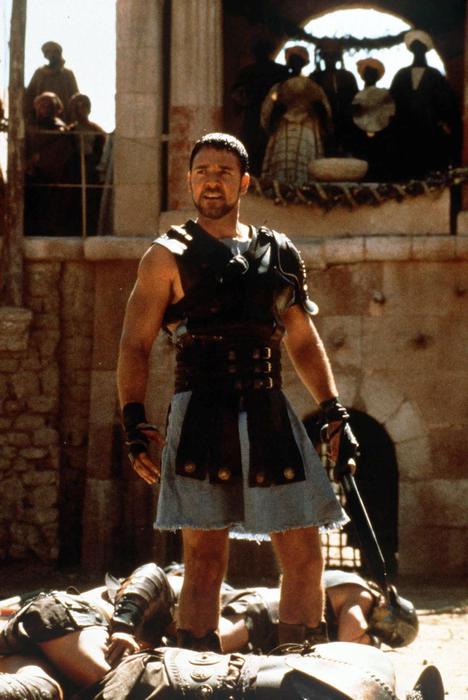The City Council of Córdoba decided to build a new neighborhood in the outskirts in 1931: Ciudad Jardín it would be called.
When the workers began to remove the ground, they came across a spectacular underground stone tomb (hypogeum) 3.7 meters long and four meters high, which was transferred to the provincial museum, although it is now next to the historic Puerta de Seville.
But it was not until 1948 when, thanks to the insistence of archaeologist Samuel de los Santos Gener, a plan to excavate that surprising find was put into operation.
Thus, specialists found a Roman necropolis with 15 tombs (five of them double) for 20 gladiators, representing 80% of all those found in Hispania.
Each burial also included a stela with a message from the deceased or his relatives for posterity.
Six of these stelae with epitaphs can now be seen in the Museum of Human Evolution, in Burgos, in the
Gladiators of Córdoba exhibition.
Death in the arena
,
as well as various elements of the funerary equipment of the wrestlers and recreations of the types of weapons they carried, on loan from the Asociación Cultural Emerita Antigua.
Juan Luis Arsuaga, director of the museum, assures that this exhibition "is the most exciting of all those organized in the museum."
“The Romans believed that you live as long as someone remembers you.
For this reason, their trails are directly directed at the walker who was passing by them ”, he emphasizes.
More information
Luxury, swimming pools and a huge guest room: the latest finds in the Roman villa of Noheda
The Law of the XII Tables of Rome, the oldest code of Roman Law to regulate coexistence (years 451-450 BC), established that no corpse could be buried or burned within the city for health reasons.
So the cemeteries were opened next to the access doors to the cities, but as the space was being occupied they extended along the roads and paths.
In this way, the deceased were remembered by walkers when reading their tombstones.
“These cemeteries, therefore, were the image of the city of the living, with its ideals, its economic position, its delimited plots, its monuments of different sizes and shapes… and their burials together, close to the amphitheater, like the 20 gladiators of Córdoba”, says María Dolores Baena, director of the Archaeological Museum of Córdoba and curator of the exhibition.
Of all the surviving tombstones, most belonged to slaves, although some have been identified as non-servile.
The 15 inscriptions studied show data on their origin (Hispanics, Germans, Greeks, Syrians or Alexandrians) and their ages, which range between 20 and 35 years, an average lifespan similar to that of the rest of the empire.
The tombstones that are exposed in Burgos, dated between the 1st and 2nd centuries AD.
C., have dedications from his wives or other family members, even from gladiators still alive.
"Whatever each of you will wish for me, already dead, that is what the gods give him, in life or in death," Actius, only 21 years old, asked to be engraved on his grave.
He died when he was celebrating his seventh match.
Reproductions of the weapons and defenses of a Roman gladiator. Ricardo Ordóñez
Satur had better luck, who survived through 13 fights that earned him a palm and a crown, with which he was buried.
Cornelia Severa, his wife, paid for everything.
And you can also see the tombstone of Stelenus, the "goalkeeper of the gladiatorial games", who had bought several burial grounds for gladiators to be buried in the vicinity of his place of work and residence.
As Cicero wrote in the
Philippics:
"As noble gladiators do, who fall with honor, let us do."
Bread and Circus
But why were they buried far from the old walled city and next to one of the main access roads to Roman Córdoba?
María Dolores Baena maintains that the gladiators were buried close to the place where they died, logically the amphitheatre.
For this reason, and given that Córdoba (Colonia Patricia) was the capital of Betica, the richest province of Rome, it had to have a circus, a theater and an amphitheatre.
None of these spectacular buildings had ever been located, but the accumulation of gladiator tombs turned out to be a fundamental clue to locate the amphitheater in 2002. The one that is considered the third largest in the empire ―178 meters in axis and 21,000 square meters in area― it had to be near the burials.
So it was,
The
ludi romani
, or shows, were collective, public and free celebrations that were always offered to the population in connection with religious festivities, according to the annual Roman calendar.
They were held in the theater (with actors), in the circus (chariot races) or in the amphitheater (gladiators and animals), the three large buildings that every important city required.
Funerary items found inside the tombs of the gladiators who died in the Córdoba amphitheater. Ricardo Ordóñez
Baena affirms that this type of spectacle could be paid for by the public treasury, but also by “socially prominent personalities and leaders who acted as
evergetas
[patrons], and who dedicated a large amount of money to finance them, especially those of gladiators, since that became a platform to gain visibility, promotion and political and social propaganda, in addition to serving as a form of social control.
'Bread and circuses', as the poet Juvenal used to say”, explains the archaeologist.
In fact, the Archaeological Museum of Córdoba, where most of the pieces now on display in Burgos come from, exhibits the pedestal of a statue of a certain Lucio Iunio Paulino, where it is said that he had organized a gladiator fight, two theatrical performances and a chariot race that cost him 400,000 sesterces.
Serve as a comparison that a slave could be bought for about 2,000 or 3,000 sesterces.
The origin of gladiator combat dates back to the 4th century BC.
C. Fights to the death were initially held to honor the memory of a deceased.
But, with the passage of time, they became very popular, and already in imperial times (from I BC) they became the public's favorite spectacle.
In fact, in Rome it was considered that gladiatorial games also served as a model to teach virtues so appreciated in the Roman world such as courage, discipline or acceptance of death.
slaves or prisoners
The fighters had very diverse origins.
They could be slaves, prisoners of war, convicted criminals, or even free men who chose their profession voluntarily.
The existence of gladiators is also known, although they represented a minimal percentage in the group.
The knowledge that we have about the lives of all of them has reached us partially through written sources and in many cases, such as that of Córdoba, through their epitaphs.
They used to live in the
ludus
, the school where they trained and formed, directed by a
lanista
or
businessman who, normally, was also its owner.
They lived with their families in those spaces that provided them with social support, security, medical attention, even a kind of death insurance.
For people with less economic power, there were
collegia tenviorum
or
funerary,
which guaranteed a dignified funeral ritual through payment in installments.
The gladiators of the same
ludus
formed a
gladiatorial family,
like the one found in Córdoba.
They fought in the amphitheaters among themselves, but also against animals.
The fights were organized by the
editor
, either with public money or with his own capital, and were regulated by referees.
After the death of the contestants, they were buried in an honorable manner, as evidenced by the funerary stelae exhibited in Burgos.
Subscribe to continue reading
Read without limits
Keep reading
I'm already a subscriber











/cloudfront-eu-central-1.images.arcpublishing.com/prisa/S7ERVSCT4FUVX6R7TUVBDNTH5Y.jpg)



